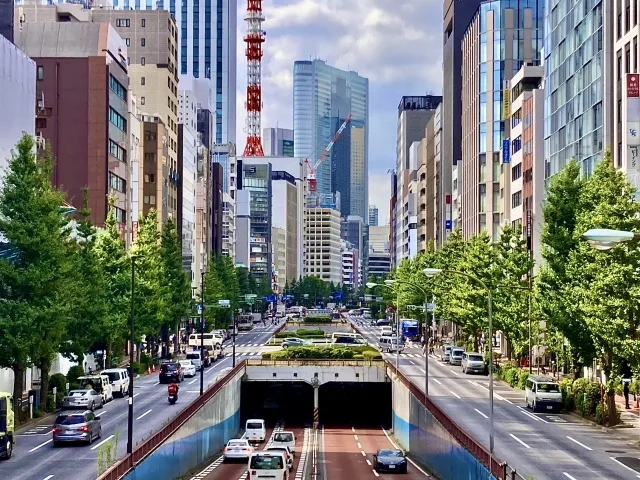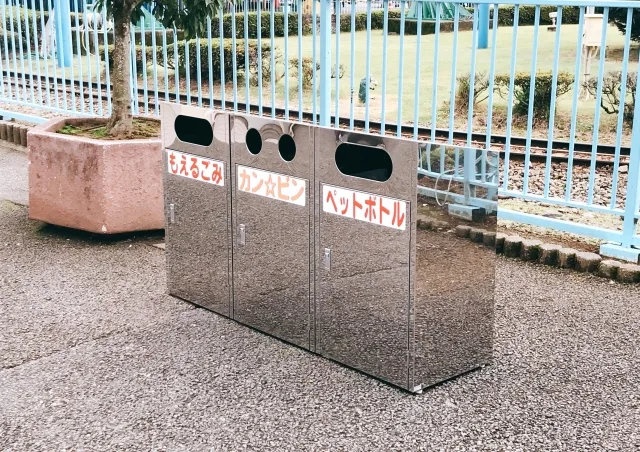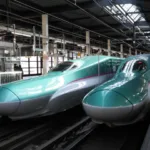When traveling in Japan, many visitors are impressed by its cleanliness and beauty. However, you may also be surprised by the scarcity of public trash bins. One reason Japanese streets remain so clean is their strict waste disposal rules and recycling systems. This article will introduce how to properly dispose of garbage during your trip to Japan and provide tips for finding trash bins.
- Why There Are Few Public Trash Bins
- Where to Find Trash Bins in Japan
- Understanding Japan’s Garbage Sorting System
- Tips for Managing Garbage While Traveling
- Apps and Websites to Help Find Trash Bins
- Garbage Etiquette During Your Japan Trip
- New Garbage Management Initiatives in Japan
- Practical Situation-Specific Garbage Disposal Guide
- Conclusion: Becoming a Responsible Traveler to Protect Japan’s Beauty
Why There Are Few Public Trash Bins

Finding trash bins in many public spaces in Japan can be difficult. This is due to several reasons:
1. Security Reasons
Following the Tokyo subway sarin attack in March 1995, many trash bins were removed from stations and public places. This terrorist incident raised awareness about the potential for hiding dangerous materials in trash bins, prompting the removal of many receptacles to ensure public safety. Even today, many stations and public facilities limit the number of trash bins or use transparent bags as a security measure.
2. Personal Responsibility and Environmental Awareness
In Japanese culture, the concept of “taking your trash home with you” is deeply ingrained. This value is taught from childhood through both family and school education. Many Japanese elementary schools have a “cleaning time” after lunch when students clean their own classrooms, teaching them to take responsibility for their own waste.
With this cultural background, many Japanese people are accustomed to carrying their trash home to sort and dispose of it properly at their residence or accommodation.
3. Maintaining Aesthetic Appeal and Reducing Cleaning Costs
Having numerous public trash bins can lead to overflowing receptacles that detract from the city’s beauty. Additionally, managing public trash bins requires regular collection and cleaning, creating a financial burden for municipalities. By reducing the number of bins, cleaning costs are cut while encouraging citizens and tourists to take responsibility for their own waste disposal.
4. Crow Countermeasures
Large crows (Jungle Crows) inhabit many Japanese urban areas and often scatter garbage from bins. Particularly in Tokyo, crow-related garbage scattering has been a problem, contributing to the reduction of trash bins. In some areas, mesh covers are installed at garbage collection points as a countermeasure against crows.
5. Promoting Recycling Through a Sorting System
Japan’s strict garbage sorting system was introduced to increase recycling rates and reduce landfill usage. Since such detailed sorting is difficult with public trash bins, proper waste sorting at homes and businesses is encouraged.
As a tourist, understanding these circumstances and following the Japanese custom of “taking your trash home with you” whenever possible would be appreciated. Especially in situations where garbage is likely to be generated, such as after eating at food courts or street stalls, it’s helpful to plan your disposal method in advance.
Where to Find Trash Bins in Japan
If you need to dispose of garbage during your trip to Japan, you can find trash bins in the following locations:
1. Convenience Stores
This is the most reliable option. Most convenience stores have trash bins inside or outside the store. However, remember that these bins are primarily for disposing of garbage from items purchased at that store. It may be considered poor manners to throw away garbage without buying anything.
2. Near Vending Machines
Many beverage vending machines have recycling bins for empty cans and PET bottles next to them. These are for recycling only and cannot be used for other types of garbage.
3. Inside Stations
Some stations have trash bins near ticket gates or on platforms. However, these are typically only for recyclable items (cans, PET bottles, newspapers, magazines). Places to dispose of regular garbage are limited.
4. Tourist Areas and Shopping Districts
In areas frequented by many tourists, new types of “smart trash bins” are being introduced. For example, in Osaka’s Dotonbori district, solar-powered trash bins called “SmaGO” that automatically compress garbage have been installed.
5. Parks
Parks usually have several trash bins, but they are often separated into recycling and combustible garbage bins.
Understanding Japan’s Garbage Sorting System

In Japan, garbage is strictly sorted. It’s important to understand that garbage sorting rules differ by municipality. Even within Tokyo’s 23 wards, separation methods and collection days vary by ward. Understanding the following basic categories will help when disposing of garbage at hotels, accommodations, or public trash bins:
1. Combustible Garbage (Moeru Gomi/Kanen Gomi/燃えるごみ)
- Food scraps and wrapping paper
- Soiled plastic containers
- Paper products (except recyclable paper)
- Wooden and textile products
- Leather products
- Disposable diapers (with waste removed)
In many municipalities, this is collected 2-3 times per week. This is the most common garbage category and accounts for the majority of household waste.
2. Non-Combustible Garbage (Moenai Gomi/Funen Gomi/燃えないごみ)
- Metal items (aluminum foil, umbrella frames, etc.)
- Glass products (broken glass, light bulbs, etc.)
- Ceramics (broken bowls and plates, etc.)
- Small household appliances
- Razor blades (safely wrapped)
In many municipalities, this is collected about 1-2 times per month.
3. Recyclable Garbage (Shigen Gomi/資源ごみ)
The degree of subdivision in this category varies particularly by municipality, but it is generally divided as follows:
- PET Bottles: Remove caps and labels, rinse lightly before disposal
- Plastic Containers and Packaging: Food trays, shampoo bottles, shopping bags, etc.
- Empty Cans: Some municipalities separate aluminum and steel cans
- Glass Bottles: May be separated by color (clear, brown, other)
- Paper:
- Newspapers (including inserts)
- Cardboard
- Magazines and books
- Paper cartons such as milk cartons
- Other paper (wrapping paper, paper bags, etc.)
Recyclables are often collected on different days depending on type. For example, cans/bottles might be collected on the 1st and 3rd Wednesdays, while PET bottles might be collected on the 2nd and 4th Wednesdays.
4. Oversized Garbage (Sodai Gomi/粗大ごみ)
- Furniture
- Bicycles
- Futons
- Large appliances (excluding air conditioners, TVs, refrigerators, washing machines)
- Other items larger than 30cm
Oversized garbage typically requires advance reservation and payment. You need to call or visit the municipal website to make a reservation, then place the item at the designated location on the specified day. Fees vary by item, and you need to purchase and attach designated stickers or tickets.
5. Special Garbage
- Hazardous/Dangerous Waste: Batteries, fluorescent lights, mercury thermometers, etc.
- Small Electronics: Smartphones, digital cameras, etc.
- Used Cooking Oil: Solidify with a coagulant or absorb with old cloth or newspaper
- Used Needles: Collection at medical institutions or pharmacies
Some municipalities have special collection boxes or specific collection days for these items.
While these classifications may vary by region, public trash bins usually clearly indicate each category with pictures or text. For accurate rules in your area of stay, we recommend checking with your accommodation staff or local tourist information center.
Tips for Managing Garbage While Traveling
1. Bring an Eco-Bag

Since July 2020, plastic shopping bags in Japan have become chargeable. Having an eco-bag is not only convenient for shopping, but also useful for temporarily storing your garbage.
2. Utilize Empty Pocket Tissue Cases
Empty pocket tissue cases are convenient for temporarily storing small pieces of garbage. You can put wrappers from street food or receipts in them.
3. Use Trash Bins at Your Accommodation
Hotels and other accommodations usually have trash bins. You can dispose of garbage accumulated during your outing after returning to your lodging.
4. Eat Street Food in Designated Areas
Some tourist areas have zones where eating while walking is prohibited. Especially in the grounds of shrines and temples and some shopping arcades, stopping to eat may be considered bad manners. Check whether eating while walking is permitted in the area.
5. Be Mindful of Sorting
When using public trash bins, follow the indicated sorting categories. Incorrect sorting creates extra work for someone who has to manually re-sort the items later.
Apps and Websites to Help Find Trash Bins
Recently, apps and websites have emerged to help find trash bins in Japan:
1. GOMI-MAP
GOMI-MAP is a non-profit web app created to help users find recycling and garbage collection spots across Japan. This app features AI image recognition technology that tells you where to dispose of different types of garbage. It primarily covers the Tokyo, Kawasaki, and Yokohama areas, with some information for the Tohoku region as well.
Features of this app:
- English interface
- Map display of disposal locations for various types of garbage
- Search capability for special waste like appliances, batteries, ink cartridges, milk cartons, and tempura oil
- User-friendly interface compared to municipal databases
This is a particularly useful tool for long-term visitors and foreign residents. The app also helps with understanding Japan’s complex garbage sorting system.
2. Municipal Websites and Multilingual Garbage Sorting Guides
Many municipalities provide detailed information about garbage sorting and collection on their official websites. In areas with many tourists, garbage sorting guides are often available in multiple languages including English and Chinese.
Almost all of Tokyo’s 23 wards provide English garbage sorting guides. For example:
- Shibuya Ward: Shibuya City Garbage and Recycling Guide
- Shinjuku Ward: Shinjuku City How to Sort and Dispose of Garbage and Recyclable Resources
- Minato Ward: Minato City Guide to Sorting Recyclables and Waste
Other major tourist cities (Kyoto, Osaka, Sapporo, Fukuoka, etc.) often provide guides in foreign languages as well.
3. Information from Tourist Information Centers and Hotels
Tourist Information Centers at major stations and tourist areas often provide information and pamphlets about local garbage disposal. Many hotels also provide cards or guides explaining garbage sorting methods for foreign tourists.
In areas with many foreign tourists, Tourist Information Center staff may be able to answer questions about garbage disposal in English or other languages.
4. Japan Travel by NAVITIME
The comprehensive travel app “Japan Travel by NAVITIME” includes location information for convenience stores and stations, indirectly helping to find trash bins. Since convenience stores often have trash bins, finding a convenience store using this app can make it easier to find a place to dispose of garbage.
Garbage Etiquette During Your Japan Trip
Littering in Japan is strongly condemned and may result in fines. Following these manners will help maintain Japan’s beautiful scenery:
1. Carry Your Trash (Take Your Garbage Home with You)
The concept of “taking your garbage home with you” is deeply rooted in Japanese culture. If you can’t find a public trash bin, carry your garbage back with you. Many Japanese people plan ahead to minimize garbage or carry small bags for this purpose.
Practical Tips:
- Get a small plastic bag when shopping at a convenience store and use it as a garbage bag
- Keep a small garbage bag inside a foldable eco-bag
- Think about how to handle packaging waste before eating street food
2. Follow Smoking Rules
In many Japanese cities, smoking on the street is prohibited. In Tokyo’s Chiyoda, Shinjuku, and Shibuya wards, among others, smoking outside designated areas may result in fines of 2,000 to 50,000 yen.
Guidelines for Smokers:
- Smoke only in designated smoking areas
- Many areas around stations and in entertainment districts have designated “smoking areas”
- Always dispose of cigarette butts in proper ashtrays
- Carrying a portable ashtray is also a good practice
3. Properly Recycle PET Bottles and Cans
Japan has a very high recycling rate for PET bottles, which are recycled into high-purity resin and transformed into new PET bottles or clothing. The correct recycling method is:
- Finish the contents completely
- Rinse lightly with water
- Remove caps and labels (dispose of these separately as “plastic”)
- Crush the bottle (some municipalities prefer uncrushed bottles)
- Place in a dedicated recycling box
4. Reduce Leftovers and Food Waste
In Japan, the value of not wasting resources is emphasized, as symbolized by the word “mottainai.”
Practical Methods:
- Order only what you can eat
- Many Japanese restaurants may provide “doggy bags” for taking leftovers home (though not all restaurants offer this service)
- Hot food or raw items may be refused for take-away due to food poisoning risks
5. Etiquette in Natural Parks and Tourist Sites
In Japan’s national parks and nature reserves, the concept of “Leave it more beautiful than you found it” is promoted.
- Always take your garbage home (most mountain areas do not have trash bins)
- On popular mountains like Mt. Fuji and Mt. Takao, “garbage pickup hiking” is encouraged, where hikers pick up not only their own trash but also any they find
- Especially at beaches and rivers, taking your garbage home is important to prevent environmental pollution
6. Handling Garbage at Local Festivals and Large Events
During cherry blossom viewing (hanami), summer festivals, and fireworks displays, temporary trash bins may be set up, but the basic rule of taking your garbage home with you still applies.
- Many festivals and events set up sorted garbage collection stations
- Food stalls may collect containers purchased from them
- After events end, volunteer cleaning activities are often organized to clean parks and streets
New Garbage Management Initiatives in Japan
As tourist numbers increase, Japan’s approach to garbage management is evolving. Here are some recent innovative initiatives:
1. Introduction of Smart Trash Bins
In areas with many tourists, new technology-enhanced trash bins are being installed. For example, Osaka’s Dotonbori district has installed smart trash bins called “SmaGO” with these features:
- Solar panels that power automatic compression when garbage reaches a certain level
- Sensors that detect garbage volume and send alerts to collection workers
- Ability to hold about 20% more garbage than conventional bins
This improves garbage collection efficiency, especially in areas with many tourists.
2. Multilingual Garbage Sorting Guides
To accommodate increasing international tourists, many municipalities are creating multilingual garbage sorting guides:
- Distribution at tourist information centers and airports
- QR code access to multilingual guides
- Intuitive displays using pictograms (emoji)
These efforts accelerated particularly in preparation for the Tokyo Olympics and Paralympics.
3. Environmental Education Programs and Volunteer Activities
In Japan, environmental volunteer activities that foreign travelers can participate in are increasing:
- Regular cleanup activities at Mt. Fuji and famous beaches
- “Ecotourism” programs for tourists
- Awareness campaigns like “#TakeHomeChallenge” using social media
By participating in these activities, you can experience Japan’s environmental conservation efforts while interacting with locals.
4. Introduction of Paid Plastic Bags and Alternative Products
Since July 2020, plastic bags have become chargeable nationwide, advancing the reduction of plastic waste:
- Convenience stores and supermarkets encourage the use of eco-bags
- Introduction of paper or biodegradable plastic bags
- Promotion of personal chopsticks and bottles with discount services
Travelers can contribute to waste reduction by bringing eco-bags during their stay in Japan.
5. Improvement of Recycling Stations
Stations and commercial facilities are installing more user-friendly sorting stations:
- Introduction of AI-powered automatic sorting machines (in some areas)
- Displays showing how recycled materials are transformed into products
- Adoption of designs that are easy to understand for tourists
These initiatives continue to evolve Japan’s waste management system. Foreign travelers can also enjoy more environmentally friendly travel by utilizing these new initiatives.
Practical Situation-Specific Garbage Disposal Guide
Here are specific garbage disposal methods for situations commonly encountered during travel in Japan:
After Shopping at Convenience Stores
- When Purchasing Beverages
- If drinking inside: Dispose in indoor or outdoor trash bins
- If carrying out: After finishing, look for trash bins at convenience stores, beside vending machines, or recycling boxes at stations
- Best practice is to remove caps and labels from PET bottles before disposal
- Food Items like Onigiri or Sandwiches
- Wrappers and plastic containers go in “combustible garbage” or “plastic”
- After eating, dispose at the convenience store trash bin or carry until you find the next convenience store
Street Food at Tourist Spots
- When Purchasing from Food Stalls
- Many stalls have trash bins nearby
- If not, prepare a small bag to carry your garbage until you finish eating
- Picnicking in Parks
- Many parks operate on the principle of “Leave it more beautiful than you found it”
- Either take all garbage home or dispose of it in designated bins in the park with proper sorting
- Particularly in popular tourist areas like Ueno Park and Shinjuku Gyoen, taking your garbage home is strongly encouraged
Eating and Drinking on Trains and Buses
- Shinkansen and Limited Express Trains
- Eating and drinking is generally permitted in reserved and non-reserved seats
- Dispose of garbage in bins provided on the train or look for bins on the platform upon arrival
- Staff may come to collect containers from bento boxes
- Regular Trains and Buses
- Avoid eating during crowded times as a matter of courtesy
- Always take your garbage with you and dispose of it properly at the station or your next destination
Handling Garbage at Accommodations
- Hotel Room Garbage
- Most hotels collect garbage daily during cleaning
- Some hotels may require sorting garbage even in guest rooms
- For long-term stays, it’s good to ask the front desk about garbage disposal
- Airbnb or Long-term Stay Facilities
- Hosts usually explain local garbage disposal rules
- If not explained, actively ask about them
- Especially for long-term stays, you need to follow local rules for taking out garbage
At Events and Festivals
- Cherry Blossom Season
- Popular cherry blossom viewing spots may have temporary special trash bins
- Basically, follow the principle of “Leave it more beautiful than you found it” and take your garbage home
- Many parks also have cleanup activities organized by the viewers themselves
- Summer Festivals and Fireworks Displays
- Large events often have temporary garbage stations
- These stations may also require sorting
- During crowded times, processing capacity may be exceeded, so consider taking garbage home if possible
Mountain Areas and Hiking
- Hiking Trails and Natural Parks
- In many mountain areas, “Take all garbage home” is an absolute rule
- Try to minimize packaging in advance to reduce waste
- Bringing waterproof ziplock bags allows you to safely carry wet garbage
- Popular Mountains like Mt. Fuji
- Especially on Mt. Fuji, an environmental conservation cooperation fee (entrance fee) is collected, part of which is used for garbage processing
- Since garbage processing capacity at the summit and mountain huts is limited, basically take your garbage back to the foot of the mountain
Beaches and Coasts
- Popular Beach Resorts
- Many beaches have trash bins, but they may be insufficient during the summer busy season
- Plastic waste in particular has a serious impact on the marine environment, so make sure to take it home
- Participating in beach cleaning activities is also a good contribution to Japan’s environmental conservation
- Remote Islands and Rural Beaches
- Due to limited waste processing facilities, always take your garbage home
- Especially on remote islands, waste processing capacity is often limited
Refer to these situation-specific guides to handle garbage smoothly during your Japan trip. With a little planning in advance, you can enjoy Japan’s beautiful scenery without being troubled by garbage issues.
Conclusion: Becoming a Responsible Traveler to Protect Japan’s Beauty
While garbage disposal in Japan may take some getting used to at first, it’s not particularly difficult once you understand the basic rules and plan a little. To summarize the content introduced in this article:
Key Points
- The concept of “taking your garbage home with you” is ingrained in Japanese culture, and tourists are expected to follow this custom.
- If you can’t find a public trash bin, look for convenience stores, beside vending machines, or stations.
- For PET bottles and cans, remove caps and labels, rinse lightly, and place in dedicated recycling boxes.
- Check the rules at your accommodation and follow the region-specific garbage sorting methods.
- Utilize apps like GOMI-MAP to find nearby trash bins and recycling stations.
- Bring eco-bags and small garbage bags when planning your trip to make garbage disposal easier.
For Sustainable Travel
Sorting and properly disposing of garbage is not just a matter of manners but an important contribution to protecting Japan’s beautiful environment. It also shows respect for local communities.
As a foreign tourist visiting Japan, respecting and cooperating with this country’s environmental conservation efforts leads to a better travel experience. By traveling with the mindset of “Leave it more beautiful than you found it,” the next generation of travelers will also be able to enjoy the same beautiful Japan.
Being mindful of proper garbage disposal is also a way to experience part of Japanese culture. If you can learn from the Japanese people’s sincere attitude toward the environment and take that back to your own country, your journey will become more meaningful.
The beauty of Japan is supported by everyone’s small efforts. Please enjoy your wonderful trip as a part of this community.
References:
- “How To Find Garbage Cans And Handle Your Trash In Japan” – MATCHA, May 7, 2020, https://matcha-jp.com/en/3618, accessed: April 28, 2025.
- “Waste disposal in Japan” – Japan Guide, https://www.japan-guide.com/e/e2222.html, accessed: April 28, 2025.
- “Trash Talk: A Guide to Garbage Disposal in Japan” – GaijinPot, July 21, 2024, https://blog.gaijinpot.com/trash-talk-a-guide-to-garbage-disposal-in-japan/, accessed: April 28, 2025.
- “GOMI-MAP app to facilitate proper waste disposal for users in Japan” – Zenbird, February 10, 2022, https://zenbird.media/gomi-map-app-to-facilitate-proper-waste-disposal-for-users-in-japan/, accessed: April 28, 2025.
- “Japan Starts Using Smart Trash Cans as Tourists Bring Garbage Problem to Cities” – Bloomberg, November 18, 2023, https://www.bloomberg.com/news/articles/2023-11-18/japan-starts-using-smart-trash-cans-as-tourists-bring-garbage-problem-to-cities, accessed: April 28, 2025.
- “How Do I Separate My Trash? A Guide to Garbage Disposal in Japan” – MATCHA, September 28, 2020, https://matcha-jp.com/en/10149, accessed: April 28, 2025.
- “Garbage Disposal In Japan: A Guide To Trash Sorting & Rules To Follow” – The Smart Local Japan, May 12, 2022, https://thesmartlocal.jp/garbage-disposal-japan/, accessed: April 28, 2025.
- “Japan’s Garbage Disposal System Explained” – Tofugu, October 9, 2014, https://www.tofugu.com/japan/garbage-in-japan/, accessed: April 28, 2025.



コメント